List of gray wolf populations by country
The global grey wolf population is estimated to be 300,000.[1] Once abundant over much of North America and Eurasia, the grey wolf inhabits a smaller portion of its former range because of widespread destruction of its habitat, human encroachment of its habitat, and the resulting human-wolf encounters that sparked broad extirpation. Considered as a whole, however, the grey wolf is regarded as being of least concern for extinction according to the International Union for the Conservation of Nature and Natural Resources. Today, wolves are protected in some areas, hunted for sport in others, or may be subject to extermination as perceived threats to people, livestock, and pets
Wolves tend to quickly adapt to change, and are often referred to as an indicator species; a species delineating an ecoregion or indicating an environmental condition such as a disease outbreak, pollution, species competition or climate change. Wolves do not seem to be able to adapt as readily to expanding civilisation the way coyotes do. While human expansion has seen an increase in the latter's numbers, it has caused a drop in those of the former.[2]
Europe
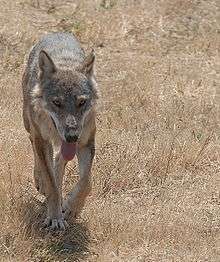

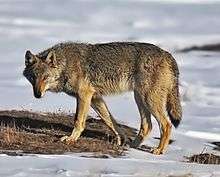
Europe, excluding Russia, Belarus and Ukraine, has 12,000 wolves in over 28 countries.[3]
Portugal has a stable wolf population of 200–300, which is afforded full protection. Compensation is paid for livestock damage.[4]
Spain's wolf population is estimated at 2,000–3,000 and growing. Their population is concentrated in two autonomous communities: around 700 in Galicia[5] and 1,600 in Castille and León[6]. Wolves are considered a game species, though they are protected in the southern regions of the country. Compensation is paid for livestock damage, though this varies according to region. The population is expanding southwards and eastwards from the northwest, having recently reached Madrid, Ávila, Guadalajara and Salamanca. A southern relict population has survived in Andalusia, although contrary to the populations in the northwest and centre of the country, it is not doing well.[7][4]
Italy's wolves are a protected species with current estimates indicating that there are 600-700 wolves living in the wild (according to other sources between 1269 and 1800 [8]. The population is steady.[9] The largest concentrations of wolves occur in the Italian national parks in Abruzzo, mostly in the Abruzzo, Lazio e Molise, in Calabria, in the Pollino, on Appennino Tosco-Emiliano, and, more recently, on the Alps. Isolated individuals have been sighted in the vicinity of human populated areas such as Tuscany, Bologna, Parma and Tarquinia.[10] Wolves have also been sighted denning 25 miles from Rome, with one small population living in the regional park of Castelli Romani.[11][12] Currently, Italian wolf populations are said to have been increasing at a rate of 6% a year since the 1970s, though 15% of the total Italian wolf population is reported to succumb annually to illegal poaching and road accidents.[10] Compensation is paid by regional governments for livestock damage.[4] Italy's leading wolf biologist, professor Luigi Boitani of the Sapienza University of Rome, expressed concern that the Italian wolf recovery may have been too successful, due to a large portion of the public refusing to concede to the possibility of rising wolf populations requiring management in the future.[12]
France's population as of 2018 is said to be more than 500 individuals and growing rapidly.[13] Wolves crossed over into Southern France from Italy through the Alps in the 1990s. Estimates in 2005 put the figure at between 80 and 100.[14] Under the Berne Convention, wolves are listed as an endangered species and killing them is illegal. Official culls are permitted to protect farm animals so long as there is no threat to the national population as a whole.[15] Compensation is paid for livestock damage.[4]
Germany's wolves were first spotted in 1998, and are thought to have migrated from western Poland.[16] In 2007, there were around 200 wolves in 36 packs roaming in Germany, most of them in the eastern German region of Lusatia.[17] In July 2012, for the first time in 150 years, wolves were born in Heidekreis in Lower Saxony, which confirms the spread of wolves from the eastern part of Germany.[18] [19] In October 2014 Lower Saxony already had a wolf population of circa 50 animals: 5 packs, all with confirmed pups in 2014, 2 confirmed mated pairs and one territorial unpaired female.[20][21] By 2019, Germany's total wolf population had grown to about 1300 individuals in 105 packs, most of them living in Brandenburg (41 packs), Saxony (22 packs) and Lower Saxony (21 packs).[22] Under German law wolves are a protected species; in several regions livestock damage compensation programmes exist.[4]
In Belgium and the Netherlands wolves were spotted in several locations in 2011. The different lone wolves are probably from the French or Italian populations.[23][24] Since wildlife corridors and wildlife crossings over highways are being created that connect wildlife areas in the Netherlands, such as the Veluwezoom National Park and the Oostvaardersplassen with the Klever Reichswald in Germany, nature conservation organisations expect wolves to migrate to the low countries in the near future.[25][26][27] In 2018, a wolf was recorded in Flanders, Belgium for the first time in over a century. The wolf's radio collar showed that it had come from Germany through the Netherlands, and that it had covered 500 km in just 10 days.[28]
Switzerland's one wolf pack is in the Calanda mountain and there are several lone wolves.[29] Wolves are afforded protection, and livestock damage compensation is paid by Cantons.[4] Swiss authorities gave permission to shoot eight wolves between the years 2000 and 2013.[30]
Norway's wolf population is located in the south-east, close to the Swedish border, and consists of around 68 wolves.[31] The population is protected and compensation is paid for livestock damage,[4] however in 2016 Norway planned to kill more than two-thirds of its population, with as many as 47 at risk of being shot. In 2015 more than 11,000 hunters applied for licenses to kill 16 wolves.[32]
Sweden's population of around 300 wolves is protected.[31] Compensation is paid for livestock damage.[33]
In Denmark the last wolf was shot in 1813, but in 2009, 2010 and 2012 there was speculation that a wolf had crossed the border from Germany due to numerous observations, with the latest in Thy National Park.[34][35] This was confirmed after an autopsy, which also concluded that the particular wolf had died from side effects of a cancerous tumor. It was the first confirmed wild wolf in Denmark for 199 years.[36] In 2013, three different lone wolves were observed in Denmark.[37] According to local biologists based on sound recordings, one pair had pups in 2013. Compensation is paid for livestock damage.[38] In July 2017 an adult wolf with eight pups was filmed, making it the first time in more than 200 years that wolfpups were confirmed to have been born in Denmark.[39] While the small Danish population originated from wolves that immigrated from Germany, DNA evidence has revealed that Danish-born wolves also have moved to Germany.[40] In 2018, it was estimated that the total population of Greenland wolves was about 200, but with significant uncertainty due to their very remote range.[41] They have been fully protected in Greenland since 1988.[42]
Finland was estimated in 2013 to have an almost stable[31] population of 97–106 wolves.[31] Wolves are legally hunted only in areas with high reindeer densities. Compensation for livestock losses are paid by the state and insurance companies.[4] The population is connected to the large Russian wolf population.[31]
Poland has a population of approximately 2500 wolves and increasing. Since 1995, they have been a protected species, and compensation is paid for livestock losses.[43]
Estonia has a quite stable wolf population of around 200, down from around 500 in the middle of the 1990s. The official standpoint considers the optimal population to be 100–200.[44] At rough scale the distribution range includes the whole country.[45] In 2007, new version of the law on nature conservation introduced compensation for livestock damage, paid by the state.[46]
Latvia has an unprotected population of 600 wolves, down from 900 in the middle of the 1990s.[47] No compensation is paid for livestock damage.
Liechtenstein has reported one wolf, possibly dispersing from Switzerland.[48]
Lithuania has a population of 300-400[49] which are increasing in number. The species is not protected, and only insured livestock receives compensation.[4]
Belarus is home to a population of 1,500–2,000 wolves.[50] With the exception of specimens in nature reserves, wolves in Belarus are largely unprotected. They are designated a game species, and bounties ranging between €60 and €70 are paid to hunters for each wolf killed. This is a considerable sum in a country where the average monthly wage is €230.[51] No compensation is paid for livestock losses.[4]
Ukraine has an unprotected, yet stable population of 2,000 wolves. Since May 2007, the killing of pregnant females and pups is banned.[52] No compensation is paid for livestock losses.[4] Many of the wolves live in the Zone of alienation north of Chernobyl, where they face few natural threats. This applies equally to the Belarusian part of the zone.[53]
Czech Republic has a stable and protected population of 20 wolves, though there are no livestock damage compensation programmes.[4]
Slovakia has a stable population of 350-400 wolves, which are considered a game species, though with some exceptions.[54] No compensation is paid for livestock losses.[4]
Slovenia has a stable population of c. 40–60 wolves.[55] Since 1991, they have been a protected species, and compensation is paid for livestock losses.
Croatia has a stable population of around 200 wolves.[56] Since May 1995, they have been a protected species, and the willful killing of wolves can result in a fine equivalent to $6,000. However, according to Dr. Djuro Huber of the University of Zagreb, illegal wolf killings increased after the protection scheme began, resulting in the deaths of 40 wolves.[12] Compensation is paid for livestock losses.[4]
Bosnia and Herzegovina is thought to have a population of 400 wolves, though they are decreasing in number and are afforded no legal protection. Compensation for livestock losses is not paid.[4]
The former State Union of Serbia and Montenegro has a stable population of 500 wolves, though it is unknown if they are afforded any protection and no compensation is paid for livestock damage.[4]
Hungary has a stable population of 250 wolves, which are protected, though with some exceptions. No compensation is paid for livestock damage.[4]
Romania has an increasing population of 2,500 wolves, which are granted legal protection.[4] No compensation is paid for livestock damage.[4]
Bulgaria has a stable population of 1,000–1,200 wolves, which are granted no legal protection.[4] Wolves are considered a nuisance and have an active bounty on them. No compensation is paid for livestock damage.[4]
Greece has a population of approximately 1,020 wolves, which are legally protected. Compensation is paid for livestock losses, with over 80% of it from insurance.[4][57]
North Macedonia has an increasing, yet unprotected population of 1,000 wolves, with no livestock compensation programmed.[4]
Albania has a protected population of 250 wolves, which are increasing in number, though no compensation is paid for livestock losses.[4]
Russian wolves have no legal protection and number 25,000–30,000, and are probably increasing in number[4] in some regions, such as Koryak Okrug and Kalmykia.[4][58] Some villages in Chechnya's Nadterechny district have been reporting increasing wolf numbers since the decrease of military activities.[59] On the other hand, in more populated regions of Central and Southern Russia the number of wolves is very small.[60] In some regions, bounties are paid for the destruction of wolves and dens.[61] Wolves live in comparatively few numbers in the Sikhote-Alin region due to competition with increasing tiger numbers.[62] This competitive exclusion of wolves by tigers has been used by Russian conservationists to convince hunters in the Far East to tolerate the big cats, as they limit ungulate populations less than wolves, and are effective in controlling the latter's numbers.[63] No livestock damage compensation is paid.[4]
Asia
Turkey has population of about 7,000. There are some local extinctions especially in the western parts of Turkey and the wolf population is declining in Turkey as a whole. Historically, the wolf has officially been considered a pest species and so it was hunted throughout the year without any limits. It was only in 2003 that the wolf received the status of a game species. Although wolves in Turkey are not legally protected, the gained status of a game species means that wolves can only be hunted with a license using established quotas which are restricted to hunting seasons. No compensation is paid for livestock damage.
Iran has a population of 3,000 wolves. As of 2015 the government pays for livestock killed by wolves. There is also a $3,000 fine for hunting wolves.
Syria has an unprotected, unknown number of wolves, thought to be roughly numbering 200. No livestock damage compensation is paid.[4]
Iraq has a stable population of around 115 wolves; no livestock compensation is paid.
Lebanon has a population of about 50 wolves. Wolves are afforded no legal protection, nor is livestock damage compensation paid.[4]
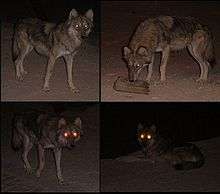
Israel has a stable population of 150 protected wolves. Some livestock damage compensation paid.[64]
Jordan has an unprotected, unknown number of wolves, thought to be roughly numbering 200. The population is decreasing due to hunting. No livestock damage compensation is paid.[4]
Saudi Arabia has a stable population of 250 to 700 wolves, which are given no legal protection. No livestock damage compensation is paid.[4]
India has a decreasing population of roughly 1,000 wolves, which are legally protected. Populations are decreasing due to hunting from farmers. No livestock damage compensation is paid.[4]
China's wolf population largely lives in areas where little human-influenced change has occurred - the Qinghai–Tibet Plateau, the Mongolia Plateau, and the northeast Plain. In 2003, an estimated 12,500 wolves were living in China. In 2015, wolves were listed as a vulnerable species in the Red List of China’s Vertebrates, with all hunting being banned for this legally protected animal.[65][66]
Mongolia has a stable population of 10,000–20,000 wolves, which are given no legal protection, nor is livestock damage compensation paid.[4]
Kazakhstan has a stable population of about 30,000 wolves.[4] About 2,000 are killed yearly for a $40 bounty, though the animal's numbers have risen sharply.[67] No livestock damage compensation is paid.[4]
Turkmenistan has a stable population of 1,000 wolves, which are unprotected. No livestock damage compensation is paid.[4]
Uzbekistan has a stable population of 2,000 wolves, which are unprotected. No livestock damage compensation is paid.[4]
Kyrgyzstan has a stable population of 4,000 wolves, which are unprotected. No livestock damage compensation is paid.[4]
Tajikistan has a population of 1,700 wolves in 2016, which are stable and unprotected.[68]
There are currently no recent or reliable estimates on wolf populations in Afghanistan, Nepal or Bhutan.[4]
North America
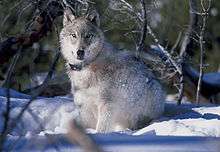
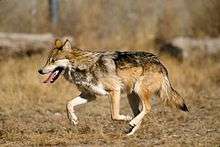
Canada has over 60,000 wolves, which are legally considered a big game species, though they are afforded protection in 3% of Canada's territory. The Northwest Territories, Nunavut and Yukon have 5,000 wolves each, British Columbia has 8,500 wolves,[69] Alberta 4,200, Saskatchewan 4,300, Manitoba 4,000-6,000, Ontario 9,000, Quebec 5,000 and Labrador 2,000. Canada currently has no livestock damage compensation programmes.[4] In the fall of 2012, the government of British Columbia was considering a cull of the wolf population in some areas.[69] In the winter of 2015 the government of British Columbia began undertaking a cull of up to 184 wolves in an effort to combat dwindling caribou populations in the South Selkirk Mountains and the South Peace region. The cull, like ones before it, is opposed by some environmental groups.[70]
On 12 March 2012, a Labrador wolf, mistakenly thought to be a coyote, was shot in Newfoundland. It was the first confirmed Labrador wolf in Newfoundland since ca. 1930.[71]
The United States as a whole has up to 18,000 wolves, about two thirds of which are in Alaska.[72] They are increasing in number in all their ranges. Usually, however, wolves in the United States are mostly seen during the winter months in northern Minnesota, northern Wisconsin, Michigan's Upper Peninsula, and portions of Washington, Idaho, northern Oregon, northwest Wyoming, and Montana, as the majority of wolf populations migrate from Canada to the Northwestern states & some of the Midwestern and Great Lakes States during the winter months for the competition over eating bison, elk, white tailed deer and other large ungulates, disputed between other carnivores such as grizzly bear, cougar, and coyote. Wolf recovery has been so successful that the United States Fish & Wildlife Service removed the western gray wolf from the federal endangered species list on March 28, 2008.[4][73] Due to the controversy over wolf shootings, a coalition of environmental groups sued the federal government to put the gray wolf back on the Endangered Species list.[74] On July 18, 2008, a federal judge ruled in favor of renewed endangered species protection.[75] Alaska has a stable population of 10,500-12,000 wolves, which are legally hunted from August to April (in deer-rich areas) as a big game species.[4][76]
Minnesota has a population of 4,100[77] wolves, which are legally protected, though they are occasionally culled for depredation control.[4] Minnesota used to have control over its wolf population,[78] but this was revoked by a federal appellate court on August 1, 2017, making wolf management the charge of the federal government.[79] The court decided to retain the state's minimum population of 1,600 animals. It has been argued by state officials that management should remain in the hands of the state, allowing for the wolf to be removed from protected status, since the population has exceeded recovery goals for more than 25 years.[79]
Both Wisconsin and Michigan have healthy populations of 750 each.[80][81] On December 19, 2014, all wolves in states of Michigan, Wisconsin, and Minnesota became protected again under the U.S. Endangered Species Act.[82]
The Northern Rocky Mountain states (Wyoming, Idaho and Montana) have an approximate population of 1,657 wolves in 282 packs (including 85 breeding pairs).[83]
Two gray wolves were captured in north-central Washington state in July 2008, one of which was a nursing female. This is the first evidence of reproducing wolves in the state since the 1930s.[84] As of the end of 2014, Washington has at least 68 wolves in 16 packs with 5 breeding pairs.[85]
In northeast Oregon, also in July 2008, wolf howls were heard by biologists who identified at least 2 adults and 2 pups. This was the first confirmed breeding pair in Oregon.[86] By December 2011, Oregon's gray wolf population had grown to 24. One of the Oregon gray wolves, known as OR-7, traveled more than 700 miles (1,100 km) to the Klamath Basin and crossed the border into California.[87] Wolf OR-7 became the first wolf west of the Cascades in Oregon since the last bounty was claimed in 1947.[88] Oregon's wolf population increased to 77 wolves in 15 packs with 8 breeding pairs as of the end of 2015.[83] As a result, Oregon Department of Fish and Wildlife proposed to delist wolves from their protected species list.[89] On January 14, 2009, the United States Department of the Interior removed the Canadian gray wolf from the Endangered Species List in every American state except Wyoming.[90] This move was blocked by lawsuits filed by conservation groups, but was successfully delisted on April 15, 2011 by the US Congress as part of a budget bill.[91] On August 31, 2012, Governor Matt Mead of Wyoming announced that wolves were no longer on the endangered species list in the state of Wyoming; therefore, they no longer need special protections from the US Fish and Wildlife Service. The wolf population in Wyoming is then controlled by the state. But on September 23, 2014, wolves in Wyoming are again listed as nonessential experimental population under the Endangered Species Act.[92]
Overall, as of the end of 2014, the Northwestern United States, with the exception of Alaska, has an estimated population of 1,802 wolves.[83]
The wolf has been extirpated from Mexico since the 1970s when the U.S. and Mexican governments cooperated to capture all remaining wild Mexican wolves and initiate a captive-breeding program in an attempt to save the local subspecies.[93] The Mexican Wolf was reintroduced into the Apache-Sitgreaves National Forest in Arizona in 1998 as part of a captive breeding program.[76] There are at least 42 wild Mexican wolves in the southwest United States in 2008.[76][93] In 2014, there are around 83 Mexican wolves in the wild.[94]
On October 27, 2014, a collared wolflike canid was seen in north of Grand Canyon, in November 2014, the same animal was videoed,[95] it was confirmed to be a northwestern wolf from the Northern Rocky Mountains in November 21, 2014.[96] On December 28, 2014, it was shot dead in southwestern Utah near the Arizona border.[97]
References
- Mech, L. David; Boitani, Luigi, eds. (2003). Wolves: Behaviour, Ecology and Conservation. University of Chicago Press. p. 230. ISBN 978-0-226-51696-7.
- Coppinger, Ray (2001). Dogs: a Startling New Understanding of Canine Origin, Behaviour and Evolution. pp. 352. ISBN 978-0-684-85530-1.
- "Europe is a Great Place to be a Large Meat-Eater".
- Mech, L. David; Boitani, Luigi, eds. (2010). Wolves: Behaviour, Ecology and Conservation. University of Chicago Press. pp. 323–324. ISBN 9780226516981 – via Google Books.
- El lobo extiende su área de distribución por el 94 % del territorio de Galicia. La Voz de Galicia.
- Censo Regional de Lobo ibérico (Canis lupus) en la Comunidad de Castilla y León 2012-2013. Junta de Castilla y León.
- "El lobo está a 27 km de Madrid". 2016-03-13.
- Galaverni, M., Caniglia, R., Fabbri, E., Milanesi, P., & Randi, E. (2016). One, no one, or one hundred thousand: how many wolves are there currently in Italy?. . Mammal Research, 61(1), 13-24.
- Esposito 2007, pp. 14-15.
- Luigi Boitani & Paolo Ciucci (2006). "Il Lupo: Operazione San Francesco" from "Salvati dall' Arca" (in Italian). p. 663. ISBN 9788883723803.
- (in Italian)Parco Regionale dei Castelli Romani
- Wolves: From Brink of Extinction to the Edge of the City
- Samuel, Henry (28 December 2018). "Wolf population surpasses 'viability' level in France, reigniting row over its protected status". The Telegraph. Telegraph Media Group Limited. Retrieved 9 April 2019.
- Christian Science Monitor, 3 Nov 2005
- Wolf Song of Alaska: France's Bardot Demands EU Action on Wolf Cull Archived 2011-09-29 at the Wayback Machine
- "The Return of Wolves to Germany". Spiegel online. Retrieved 2007-02-07.
- "Aktueller Bestand in Deutschland". Wolfsregion Lausitz online. Retrieved 2007-11-02.
- "Wolfswelpen in Munster tappen in Fotofalle". NDR. Retrieved 2012-08-07.
- "Niedersachsenwolf". Retrieved 2012-08-07.
- "Wolfsnachweise in Niedersachsen". Wildtiermanagement Niedersachsen. Retrieved 2014-11-30.
- "Wölfe in Niedersachsen". Niedersäschisches Ministerium für Umwelt, Energie und Klimaschutz. Retrieved 2014-11-30.
- "Schon 105 Rudel: Immer mehr Wölfe in Deutschland". rnd.de (in German). Retrieved 2020-05-09.
- "Duitse wolf blijkt Italiaan". wolveninnederland.nl. Retrieved 9 July 2012.
- "De wolf: terug in België". wolveninnederland.nl. Retrieved 9 July 2012.
- "Wolf caught on camera trap in Belgium – Video". wildlifeextra.com. Retrieved 9 July 2012.
- "terugkomst wolf nog onzeker". ARK Natuurontwikkeling. Retrieved 9 July 2012.
- "Wolf nu ook gezien op de Veluwe". Noord Hollands Dagblad. Retrieved 9 July 2012.
- Wolf found in northern Belgium, first time in over 100 years
- "Wolfspräsenz in der Schweiz 2016".
- "KORA: Verluste".
- Svensson, Linn. et al. (2013). Varg i Skandinavien och Finland: Slutrapport från inventering av varg vintern 2012–2013, Høgskolen i Hedmark Oppdragsrapport nr 6. 2013. Elverum. Flisa trykkeri. ISBN 978-82-7671-905-5
- "Norway plans to cull more than two-thirds of its wolf population". The Guardian. September 16, 2016. Retrieved October 8, 2016.
- Swedish EPA (2008-12-05). "Etappmålen för järv och varg uppnått" Archived 2012-02-15 at the Wayback Machine. Press release. Retrieved on 2009-05-30
- "En ulv i Danmark?" [A wolf in Denmark?] (in Danish). Danish Forest and Nature Agency. 17 February 2010. Retrieved 2012-10-18.
- "Enlig, strejfende ulv er måske set i Nationalpark Thy" [Single, stray wolf may be seen in Thy National Park] (in Danish). Danish Forest and Nature Agency. 17 October 2012. Retrieved 2012-10-18.
- "Det var en ulv" [It was a wolf] (in Danish). Danish Forest and Nature Agency. 7 December 2012. Retrieved 2012-12-07.
- "Ulve i Danmark" [Wolves in Denmark] (in Danish). Danish Forest and Nature Agency. 22 October 2013. Archived from the original on 29 October 2013. Retrieved 2013-11-11.
- "Midlertidig kompensationsordning for skader forvoldt af ulv" [Temporary compensation for livestock damage caused by wolf] (in Danish). Danish Forest and Nature Agency. 4 July 2013. Retrieved 2013-11-11.
- "Ulveunger i Danmark: Antal opjusteret". 2017-07-03.
- "Danskfødte ulve er udvandret til Tyskland" [Danish-born wolves have immigrated to Germany] (in Danish). TV Syd. 1 June 2018. Retrieved 22 December 2019.
- "Issittup amarua nunatsinni immikkuullarissuusoq" [The wolf in Greenland is a population of its own] (in Kalaallisut). Kalaallit Nunaata Radioa (Greenlandic Broadcasting Corporation). 13 November 2018. Retrieved 22 December 2019.
- "Amaqqut Kalaallit Nunaanni eqqissisimatinneqarnissaat pillugu Namminersornerullutik Oqartussat nalunaarutaat nr. 9, 5. maj 1988-imeersoq" [Home Rule announcement no. 5 regarding the protection of wolves in Greenland, 5 May 1988] (in Kalaallisut). Home Rule of Greenland. 5 May 1988. Retrieved 22 December 2019.
- "Ile jest faktycznie wilków w Polsce i czy stanowią zagrożenie?" [What is the real number of wolves in Poland and do they cause a danger?] (in Polish). Andrzej Turczyn Trybun Broni Palnej. 2 September 2017.
- (in Estonian)Keskkonnainfo: hunt
- "Report on the conservation status and threats for wolf (Canis lupus) in Europe" (PDF). Archived from the original (PDF) on 2007-09-27. Retrieved 2007-11-24.
- "Looduskaitseseadus". Riigi Teataja (in Estonian). Retrieved 2007-11-24.
- http://www.daba.gov.lv/upload/File/DOC/SAP_Vilks-08_EN.pdf
- First ever wolf visits Liechtenstein
- http://www.am.lt/VI/index.php#a/6797
- "Archived copy" (PDF). Archived from the original (PDF) on 2010-06-21. Retrieved 2014-02-06.CS1 maint: archived copy as title (link)
- "Archived copy" (PDF). Archived from the original (PDF) on 2012-02-22. Retrieved 2007-12-23.CS1 maint: archived copy as title (link)
- Охрана волков [Protection of wolves] (in Russian). 5 September 2014.
- http://www.whatson-kiev.com/index.php?go=News&in=view&id=4806
- "Kvóta lovu vlka dravého pre poľovnícku sezónu 2013/2014" [Hunting regulation for wolf hunting season 2013/2014] (in Slovak). 5 September 2014.
- Trček, Petra (14 March 2017). "Pri nas živi okoli 52 volkov, večina na Notranjskem in Kočevskem" [52 Wolves Live in Slovenia, Mostly in Inner Carniola and the Gottschee Region]. Notranjskoprimorske novice (in Slovenian).
- Gomerčić; et al. "High genetic variability of grey wolf (Canis lupus L.) population from Croatia as revealed by mitochondrial DNA control region sequences".
- (PDF) http://ec.europa.eu/environment/nature/conservation/species/carnivores/pdf/60_Mertzanis_monitoring%20methods%20Greece.pdf. Missing or empty
|title=(help) - Волки: серое нашествие (in Russian). Аргументы и факты. 2001-12-04. Retrieved 2008-08-14.
- Wolves Go on Offensive in Chechnya, Ruslan Isayev, Prague Watchdog September 25, 2007
- "Canis Lupus" (in Russian). Ecosystem.
- Объявлен конкурс по борьбе с волками (in Russian). Official Informer of Tomsk Government. Retrieved 2009-09-14.
- "Tigers and Wolves in the Russian Far East: Competitive Exclusion, Functional Redundancy, and Conservation Implications". savethetigerfund.org. Archived from the original on 2007-10-30. Retrieved 2008-07-09.
- Wildlife Science: Linking Ecological Theory and Management Applications, By Timothy E. Fulbright, David G. Hewitt, Contributor Timothy E. Fulbright, David G. Hewitt, Published by CRC Press, 2007, ISBN 0849374871
- http://wolfpreservation.me/2013/09/03/only-2-countries-in-the-middle-east-protect-the-wolf/
- Xu, Y.; Yang, B.; Dou, L. (2015). "Local villagers' perceptions of wolves in Jiuzhaigou County, western China". PeerJ. 3: e982. doi:10.7717/peerj.982. PMC 4465947. PMID 26082870.
- Fang, H.; Ping, X. (2016). "Red List of China's Vertebrates". Biodiversity Science. 24 (5): 500–551. doi:10.17520/biods.2016076.Canis lupus status=NT (Near Threatened)
- "Is Kazakhstan Home to the World's Largest Wolf Population?". Christopher Pala. National Wildlife Federation. Archived from the original on 2011-08-26. Retrieved 2007-09-28.
- Goldthorpe G. 2016. The wolf in Eurasia - a regional approach to the conservation and management of a top predator in Central Asia and the South Caucasus. Fauna and Flora International.
- "B.C. considering wolf culls in new management plan". CBC News.
- "B.C. Will shoot wolves from helicopter to protect dwindling caribou | CBC News".
- "Bonavista, N.L., 'coyote' was really wolf, tests confirm | CBC News".
- "Gray Wolf Population in the U.S".
- "U.S. Fish & Wildlife Service Gray Wolf webpage". U.S. Fish & Wildlife Service. Retrieved 2008-04-23.
- Johnson, Kirk (2008-04-13). "In the West, a Fierce Battle over Wolves". The New York Times. Retrieved 2008-04-23.
- Barringer, Felicity (2008-07-19). "Judge Returns Gray Wolves to Endangered List". New York Times. Retrieved 2008-07-19.
- "Wolf management". Minnesota Department of Natural Resources. Retrieved 2008-01-13.
- Gray Wolf Population in Minnesota, Wisconsin, and Michigan (excluding Isle Royale) from 1976–2008, US Fish and Wildlife Service
- "Wolf populations around the world and their status". Archived from the original on 2003-01-08. Retrieved 2008-01-13.
- Kraker, Dan (August 1, 2017). "Federal court keeps MN wolves under endangered species protection". MPR News. Retrieved August 16, 2017.
- "Archived copy". Archived from the original on 2010-08-05. Retrieved 2011-03-30.CS1 maint: archived copy as title (link)
- "Dnr - Dnr".
- "Judge returns Great Lakes wolves to endangered species list". 2014-12-22.
- "U.S. Fish and Wildlife Service, State Agencies Release 2014 Northern Rocky Mountain Wolf Population Numbers". fws.gov. April 3, 2015. Retrieved April 19, 2015.
- "State biologists capture Okanogan wolves". Seattle Times. 2008-07-19. Retrieved 2008-07-19.
- Gray Wolf Conservation and Management-Wolf Packs in Washington-Annual Report-Pack Statistics-(as of December 31, 2014)
- Milstein, Michael (2008-07-22). "Wolves breeding again in Oregon". The Oregonian.
- "Former Imnaha pack wolf OR-7 enters California". Wallowa County Chieftain. Enterprise, Oregon. December 29, 2011. Retrieved January 14, 2012.
- "Don't stop believing...The journey of OR7". Oregon Wild. Portland, Oregon. January 4, 2012. Retrieved January 29, 2012.
- Darling, Dylan (April 22, 2015). "ODFW: Wolf ready for state delisting Gray wolf could be coming off of Oregon's protected species list". Retrieved April 23, 2015.
- "Bush delists gray wolf in majority of U.S." Washington Times. 2009-01-19.
- Nasaw, Daniel (2011-04-15). "Congress strips grey wolf endangered species protection". BBC News. Retrieved 15 September 2012.
- "Judge restores protections to wolves in Wyoming".
- "Mexican Wolf Blue Range Reintroduction Project Statistics" (PDF). USFWS. Retrieved 2008-01-13.
- http://www.fws.gov/southwest/es/mexicanwolf/index.cfm
- https://www.youtube.com/watch?v=Su_NvK2Lfv8
- http://www.fws.gov/southwest/es/mexicanwolf/pdf/Grand_Canyon_Canid_fNR.11-20-14.pdf
- "Endangered grey wolf spotted in Grand Canyon for first time in 70 years shot dead by blundering hunter". 2015-02-12.
Bibliography
Carmine Esposito (2007). "Il Lupo" Roma- Franco Muzzio Editore. p. 127. ISBN 9788874131433.